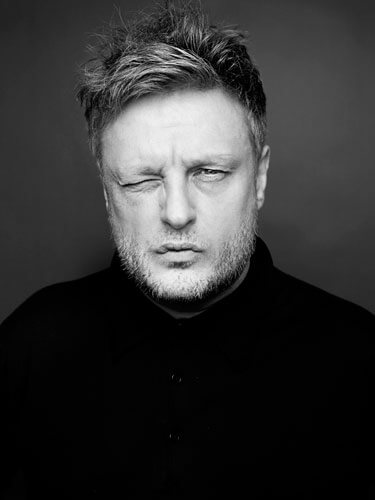Synonymous with compelling portraiture, Rankin's lens captures, creates and unveils icons.
Rankin made his name in publishing, founding the seminal monthly magazine
Dazed & Confused with
Jefferson Hack in 1992. It provided a platform for innovation for emerging stylists, designers, photographers and writers. The magazine went on to forge a distinctive mark in the arts and publishing spheres, and developed a cult status by forming and moulding trends, and bringing some of the brightest lights in fashion to the foreground.
Rankin has created landmark editorial and advertising campaigns. His body of work features some of the most celebrated publications, biggest brands and pioneering charities, including Nike, Swatch, Dove, Pantene, Diageo, Women's Aid, and Breakthrough Breast Cancer. He has shot covers for
Elle, German
Vogue,
Harper's Bazaar,
Esquire,
GQ,
Rolling Stone and
Wonderland. His work has always endeavoured to question social norms and ideas of beauty and, in late 2000, Rankin published the heteroclite quarterly Rank, an experimental anti-fashion magazine celebrating the unconventional.
In 2001, Jefferson and Rankin launched
AnOther Magazine. With a focus on fashion, originality, and distinction. In response to the expanding menswear market, in 2005 AnOther Man was introduced, combining intelligent editorial with groundbreaking design and style. More recently, the
Dazed Group has established itself as an online authority, via AnOthermag.com, Dazeddigital.com and Dazedtv.com. Rankin celebrated Dazed & Confused's 20th anniversary, shooting 20 front covers of Dazed favourites and 20 inside covers of the next generation of talent, for the December 2011 issue.
Tapping into the consciousness of the 90s and 00s with his intimate approach and playful sense of humour, Rankin became known for his portraiture of bands, artists, supermodels and politicians. Having photographed everyone from the
Queen of England to the
Queen of Pop, Rankin is often seen as a celebrity photographer. However, his plethora of campaigns and projects featuring 'real women' marked him out as a genuinely passionate portrait photographer, no matter who the subject. Always pursuing personal projects which push his limits, high impact charity projects, and groundbreaking commercial campaigns, Rankin has stood out for his creative fearlessness. His first major worldwide and award-winning campaign - Dove's 'Real Women' - epitomised his approach: to reveal the honesty of the connection and
collaborative process between photographer and subject. Personal or commercial, Rankin's images have become part of contemporary iconography, evidence of his frankness and passion for all aspects of modern culture, and its representation in the photographed image.
Rankin has published over 30 books, is regularly exhibited in galleries around the world, as well as his own London gallery. His museum-scale exhibition
Show Off opened at
NRW Dusseldorf in September 2012, pulling in over 30,000 visitors in 3 months.
In the last few years, he has frequently turned his hand to studies of photography through TV presenting. Working with the BBC, he has featured in a number of seminal documentaries -
The Seven Photographs that Changed Fashion,
South Africa in Pictures,
Shooting the Stars,
The Life Magazine Photographers and most recently, an in-depth documentary into the modern approach to death in,
Alive: In the Face of Death.
His affiliation with charities has seen Rankin travel the world, creating powerful campaigns both as a photographer and a director. With Oxfam, he visited the Democratic Republic of the Congo and Kenya, and in 2011 hosted an Oxglam exhibition, featuring work from some of the world's most talented emerging young photographers, and raising money for the charity. 2013 sees a planned trip to Jordan and Lebanon with Oxfam.
In 2009, Rankin undertook the biggest project of his career -
Rankin Live, a mammoth, interactive spectacle and exhibition. Always interested in the democratisation of the image, and also a keen advocate of the amazing digital advances of the photographic industry, Rankin Live was the culmination of the accessibility and speed of modern photography. Rankin proved that everyone can look like a magazine cover star as, for 7 straight weeks, he photographed people off the street, one every 15 minutes - retouching, printing and hanging the image within half an hour of the shutter being fired. Rankin photographed over 1600 Londoners, before then taking Rankin Live on tour in Mexico and New York.
In 2011,
Rankin Film Productions was born. Rankin developed a taste for film directing music videos, commercials, and short films with co-director Chris Cottam between 2002 and 2009, including their debut feature film, The Lives of Saints. Written by Toni Grisoni (Fear and Loathing in Las Vegas), it won the grand jury prize at the Salento International Film Festival. Since 2009, Rankin has continued to direct independently on both commercial and personal projects. Taking on the new role of Executive Producer, Rankin recently founded
Collabor8te, in association with
The Bureau and
Dazed TV. Collabor8te calls on scriptwriters and directors to submit their ideas for narrative film, promising to turn a selection of these dreams into a reality, producing them, featuring them on Dazed TV, and running them on the international film festival circuit.
In November 2011, Rankin returned to magazine publishing with a fresh offering - The Hunger. A biannual fashion, culture and lifestyle magazine, The Hunger and its associated Hunger TV website - a video-based digital platform featuring in-depth interviews, fashion films, blogs, updates, and previews - marked Rankin's return to the fashion world with an understanding that the future is not only printed but digital too.
Rankin lives in London with his wife, Tuuli, and son, Lyle.
